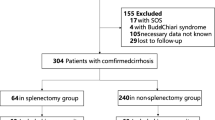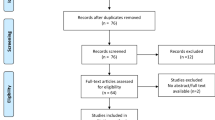Abstract
Portal vein thrombosis (PVT) consists of two different entities: acute PVT and chronic PVT. Acute PVT usually presents as abdominal pain. When the thrombus extends to the mesenteric venous arches, intestinal infarction can occur. Chronic PVT is usually recognized after a fortuitous diagnosis of hypersplenism or portal hypertension, or when there are biliary symptoms related to portal cholangiopathy. Local risk factors for PVT, such as an abdominal inflammatory focus, can be identified in 30% of patients with acute PVT; 70% of patients with acute and chronic PVT have a general risk factor for PVT, most commonly myeloproliferative disease. Early initiation of anticoagulation therapy for acute PVT is associated with complete and partial success in 50% and 40% of patients, respectively. A minimum of 6 months' anticoagulation therapy is recommended for the treatment of acute PVT. For patients with either form of PVT, permanent anticoagulation therapy should be considered if they have a permanent risk factor. In patients with large varices, β-adrenergic blockade or endoscopic therapy seems to prevent bleeding as a result of portal hypertension, even in patients on anticoagulation therapy. In patients with jaundice or recurrent biliary symptoms caused by cholangiopathy, insertion of a biliary endoprosthesis is the first treatment option. Overall, the long-term outcome for patients with PVT is good, but is jeopardized by cholangiopathy and transformation of underlying myeloproliferative disease into myelofibrosis or acute leukemia.
Key Points
-
Acute or chronic portal vein thrombosis (PVT) suggests the presence of one or several underlying prothrombotic disorders
-
Myeloproliferative disease that lacks the usual diagnostic features is the most frequent prothrombotic disorder in patients with PVT
-
Major complications comprise intestinal infarction, chronic portal hypertension, and portal cholangiopathy, while liver function is preserved
-
In most patients with acute PVT, complete or partial recanalization is achieved with early anticoagulation therapy
-
Permanent anticoagulation should be considered in patients with permanent prothrombotic disorders who present with acute or chronic PVT
This is a preview of subscription content, access via your institution
Access options
Subscribe to this journal
Receive 12 print issues and online access
$209.00 per year
only $17.42 per issue
Buy this article
- Purchase on Springer Link
- Instant access to full article PDF
Prices may be subject to local taxes which are calculated during checkout









Similar content being viewed by others
References
Primignani M et al. (2005) Risk factors for thrombophilia in extrahepatic portal vein obstruction. Hepatology 41: 603–608
Condat B et al. (2001) Current outcome of portal vein thrombosis in adults: risk and benefit of anticoagulant therapy. Gastroenterology 120: 490–497
El-Karaksy H et al. (2004) Prevalence of factor V Leiden mutation and other hereditary thrombophilic factors in Egyptian children with portal vein thrombosis: results of a single-center case-control study. Ann Hematol 83: 712–715
Arora NK et al. (1998) Portal hypertension in north Indian children. Indian J Pediatr 65: 585–591
Ueno N et al. (1997) Color Doppler ultrasonography in the diagnosis of cavernous transformation of the portal vein. J Clin Ultrasound 25: 227–233
Mathieu D et al. (1985) Portal thrombosis: dynamic CT features and course. Radiology 154: 737–741
Ide T (2003) Early development of cavernomatous vasculatures in portal venous thrombosis: morphometric kinetics in rabbit model. Hepatology Research 27: 136–142
Kumar S et al. (2001) Mesenteric venous thrombosis. N Engl J Med 345: 1683–1688
Webb LJ and Sherlock S (1979) The aetiology, presentation and natural history of extra-hepatic portal venous obstruction. Q J Med 192: 627–639
Sheen CL et al. (2000) Clinical features, diagnosis and outcome of acute portal vein thrombosis. Q J Med 93: 531–534
Condat B et al. (2000) Recent portal or mesenteric venous thrombosis: increased recognition and frequent recanalization on anticoagulant therapy. Hepatology 32: 466–470
Denninger MH et al. (2000) Etiology of splanchnic venous thrombosis in adults: the role of mutiple concurrent factors. Hepatology 31: 587–591
Janssen HL et al. (2000) Factor V Leiden mutation, prothrombin gene mutation, and deficiencies in coagulation inhibitors associated with Budd–Chiari syndrome and portal vein thrombosis: results of a case–control study. Blood 96: 2364–2368
Chamouard P et al. (1999) Frequent factor II G20210A mutation in idiopathic portal vein thrombosis. Gastroenterology 116: 144–148
Mahmoud AE et al. (1997) Prevalence of the factor V Leiden mutation in hepatic and portal vein thrombosis. Gut 40: 798–800
Bhattacharyya M et al. (2004) Inherited prothrombotic defects in Budd–Chiari syndrome and portal vein thrombosis: a study from North India. Am J Clin Pathol 121: 844–847
Mohanty D et al. (2001) Hereditary thrombophilia as a cause of Budd–Chiari syndrome: a study from Western India. Hepatology 34: 666–670
Hassn AM et al. (2000) Portal vein thrombosis following splenectomy. Br J Surg 87: 362–373
Valla D et al. (1988) Etiology of portal vein thrombosis in adults: a prospective evaluation of primary myeloproliferative disorders. Gastroenterology 94: 1063–1069
Chait Y et al. (2005) Relevance of the criteria commonly used to diagnose myeloproliferative disorder in patients with splanchnic vein thrombosis. Br J Haematol 129: 553–560
Cardin F et al. (1992) Adult “idiopathic” extrahepatic venous thrombosis. Importance of putative “latent” myeloproliferative disorders and comparison with cases with known etiology. Dig Dis Sci 37: 335–339
Lamy T et al. (1997) Inapparent polycythemia vera: an unrecognized diagnosis. Am J Med 102: 14–20
James C et al. (2005) A unique clonal JAK2 mutation leading to constitutive signalling causes polycythaemia vera. Nature 434: 1144–1148
Levine RL et al. (2005) Activating mutation in the tyrosine kinase JAK2 in polycythemia vera, essential thrombocythemia, and myeloid metaplasia with myelofibrosis. Cancer Cell 7: 387–397
Baxter EJ et al. (2005) Acquired mutation of the tyrosine kinase JAK2 in human myeloproliferative disorders. Lancet 365: 1054–1061
Kralovics R et al. (2005) A gain-of-function mutation of JAK2 in myeloproliferative disorders. N Engl J Med 352: 1779–1790
Ginsberg JS (1996) Management of venous thromboembolism. N Engl J Med 335: 1816–1828
Baril N et al. (1996) The role of anticoagulation in pylephlebitis. Am J Surg 172: 449–452
Lagasse JP et al. (1997) Acute thrombosis of the portal system. Treatment with alteplase and heparin or with heparin alone in 10 patients. Gastroenterol Clin Biol 21: 919–923
Rahmouni A et al. (1992) Value of CT scan and sonography in the conservative management of acute splenoportal and superior mesenteric venous thrombosis. Gastrointest Radiol 17: 135–140
De Franchis R (2005) Evolving consensus in portal hypertension. Report of the Baveno IV consensus workshop on methodology of diagnosis and therapy in portal hypertension. J Hepatol 43: 167–176
Hollingshead M et al. (2005) Transcatheter thrombolytic therapy for acute mesenteric and portal vein thrombosis. J Vasc Interv Radiol 16: 651–661
Plemmons RM et al. (1995) Septic thrombophlebitis of the portal vein (pylephlebitis): diagnosis and treatment in the modern era. Clin Infect Dis 21: 1114–1120
Joh JH and Kim DI (2005) Mesenteric and portal vein thrombosis: treated with early initiation of anticoagulation. Eur J Vasc Endovasc Surg 29: 204–208
Eugene C et al. (1995) Small intestinal stricture complicating superior mesenteric vein thrombosis. A study of three cases. Gut 37: 292–295
Condat B et al. (2003) Portal cavernoma-associated cholangiopathy: a clinical and MR-cholangiography coupled with MR-portography imaging study. Hepatology 37: 1302–1308
Lai L and Brugge WR (2004) Endoscopic ultrasound is a sensitive and specific test to diagnose portal venous system thrombosis. Am J Gastroenterol 99: 40–44
Kreft B et al. (2000) Detection of thrombosis in the portal venous system: comparison of contrast-enhanced MR angiography with intraarterial digital subtraction angiography. Radiology 216: 86–92
Vilgrain V et al. The atrophy/hypertrophy complex in patients with portal cavernoma: a CT study. Radiology, in press
Palazzo L et al. (2000) Biliary varices on endoscopic ultrasonography: clinical presentation and outcome. Endoscopy 32: 520–524
Dumortier J et al. (2003) Diagnosis and treatment of biliary obstruction caused by portal cavernoma. Endoscopy 35: 446–450
Orr DW et al. (2005) Chronic portomesenteric and portosplenomesenteric venous thrombosis: evaluation of long term follow up and determinants of survival [abstract]. Hepatology 42 (Suppl 1): 212A
Celinska-Cedro D et al. (2003) Endoscopic ligation of esophageal varices for prophylaxis of first bleeding in children and adolescents with portal hypertension: preliminary results of a prospective study. J Pediatr Surg 38: 1008–1011
Voorhees AB Jr and Price JB Jr (1974) Extrahepatic portal hypertension. A retrospective analysis of 127 cases and associated clinical implications. Arch Surg 108: 338–341
Senzolo M et al. (2006) Transjugular intrahepatic portosystemic shunt for portal vein thrombosis with and without cavernous transformation. Aliment Pharmacol Ther 23: 767–775
Chaudhary A et al. (1998) Bile duct obstruction due to portal biliopathy in extrahepatic portal hypertension: surgical management. Br J Surg 85: 326–329
Okuda K et al. (1985) Incidence of portal vein thrombosis in liver cirrhosis. An angiographic study in 708 patients. Gastroenterology 89: 279–286
Tublin ME et al. (1997) Benign and malignant portal vein thrombosis: differentiation by CT characteristics. Am J Roentgenol 168: 719–723
Dodd GD et al. (1995) Portal vein thrombosis in patients with cirrhosis: does sonographic detection of intrathrombus flow allow differentiation of benign and malignant thrombus? Am J Roentgenol 165: 573–577
De Sio I et al. (1995) Ultrasound-guided fine needle aspiration biopsy of portal vein thrombosis in liver cirrhosis: results in 15 patients. J Gastroenterol Hepatol 10: 662–665
Amitrano L et al. (2004) Risk factors and clinical presentation of portal vein thrombosis in patients with liver cirrhosis. J Hepatol 40: 736–741
Nonami T et al. (1992) The incidence of portal vein thrombosis at liver transplantation. Hepatology 16: 1195–1198
Amitrano L et al. (2000) Inherited coagulation disorders in cirrhotic patients with portal vein thrombosis. Hepatology 31: 345–348
Erkan O et al. (2005) Thrombophilic gene mutations in cirrhotic patients with portal vein thrombosis. Eur J Gastroenterol Hepatol 17: 339–343
Amitrano L et al. (2002) Portal vein thrombosis after variceal endoscopic sclerotherapy in cirrhotic patients: role of genetic thrombophilia. Endoscopy 34: 535–538
Freedman AM et al. (1993) Complications of transjugular intrahepatic portosystemic shunt: a comprehensive review. Radiographics 13: 1185–1210
Rossi P et al. (1976) Portal thrombosis: high incidence following splenectomy for portal hypertension. Gastrointest Radiol 1: 225–227
Jin GL and Rikkers LF (1991) The significance of portal vein thrombosis after distal splenorenal shunt. Arch Sur 126: 1011–1015
Francoz C et al. (2005) Splanchnic vein thrombosis in candidates for liver transplantation: usefulness of screening and anticoagulation. Gut 54: 691–697
Cavallari A et al. (2001) Treatment of vascular complications following liver transplantation: multidisciplinary approach. Hepatogastroenterology 48: 179–183
Settmacher et al. (2000) Venous complications after orthotopic liver transplantation. Clin Transplant 14: 235–241
Acknowledgements
We are most indebted to Valérie Vilgrain (Service de Radiologie), Marie-Hélène Denninger (Service d'Immunohématologie), Dominique Cazals-Hatem (Service d'Anatomie et Cytologie Pathologiques), and Jean Brière and Jean-Jacques Kiladjian (Service d'Hématologie), Hôpital Beaujon, Clichy, for their collaboration. Supported in part by the fifth framework program of the European Union (EN-Vie QLG1-CT-2002-16786), GIS Maladies Rares, and French Ministère de la Santé (Centre de référence des Maladies Vasculmaires du Foie).
Author information
Authors and Affiliations
Corresponding author
Ethics declarations
Competing interests
The authors declare no competing financial interests.
Rights and permissions
About this article
Cite this article
Condat, B., Valla, D. Nonmalignant portal vein thrombosis in adults. Nat Rev Gastroenterol Hepatol 3, 505–515 (2006). https://doi.org/10.1038/ncpgasthep0577
Received:
Accepted:
Issue Date:
DOI: https://doi.org/10.1038/ncpgasthep0577
This article is cited by
-
Postoperative Portomesenteric Venous Thrombosis After Colorectal Cancer Surgery
Journal of Gastrointestinal Surgery (2020)
-
Imaging and minimally invasive endovascular therapy in the management of portal vein thrombosis
Abdominal Radiology (2018)
-
Postoperative Portomesenteric Venous Thrombosis: Lessons Learned From 1,069 Consecutive Laparoscopic Colorectal Resections
World Journal of Surgery (2014)



